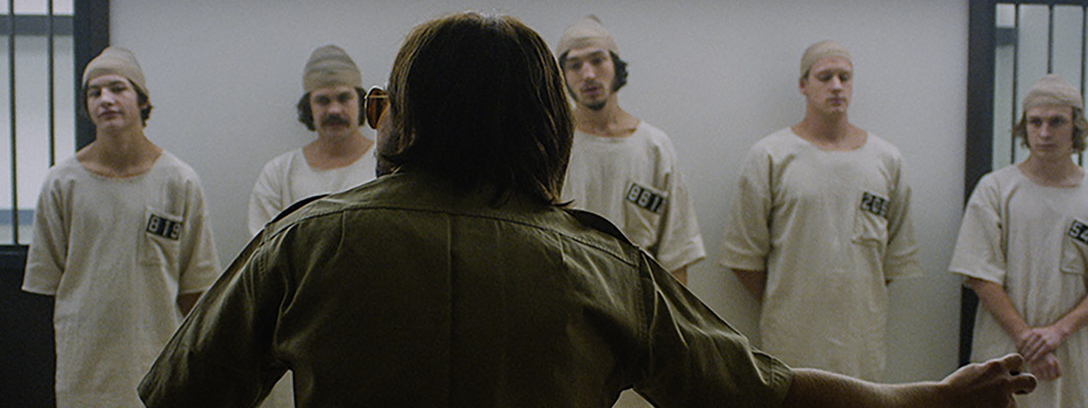Nate von Zumwalt
Director Kyle Patrick Alvarez may not be the second coming of Dr. Philip Zimbardo, the groundbreaking psychologist at the helm of the Stanford Prison Experiment, but that doesn’t preclude his new film from channeling the same chilling tenor as those controversial events.
One could speculate that every film screening is an “experiment” of sorts, as a number of audience members intimated during The Stanford Prison Experiment’s Q&A session at the film’s Sundance premiere, but Alvarez is loath to concede that his film manipulates with the same scheming tendencies as the experiment itself.
One of the things that I found really fascinating about the experiment was that they walked away—they ended it. It was ultimately more an expression of humanity than it was of how bad humanity is.
—Kyle Patrick Alvarez
About that experiment (which Alvarez worked pedantically to adhere to in the film, including enlisting Zimbardo as a consultant). In the summer of 1971, Zimbardo (played by Billy Crudup in the film) began work on a project that would simulate the conditions of a prison by soliciting 24 exceedingly “normal” men to play the roles of guards and prisoners.
Assigned at random, the participants inhabit their roles on a 24/7 basis and under the analytical surveillance of Zimbardo and his team. With only a basic—and albeit ambiguous—condition that the “guards” may not physically assault the “prisoners,” the experiment becomes increasingly disconcerting as a number of guards adopt a fascistic approach in response to the prisoners’ unruly behavior—most notably an increasingly unstable prisoner played by Ezra Miller.
Just as the guards begin to revel in their new authority, the prisoners find that the “experiment” is more closely aligned with reality than simulation. Not even two days into the project, Miller’s character begins to break down after a protracted stint in ‘the hole,’ a room for solitary confinement from which he pleads for a release while proclaiming that the experiment is not allowed to “fuck with my head.” As the project takes on a life of its own, Zimbardo and his team are forced to reconcile the potential benefits of their research with the traumatic repercussions for its subjects.
It would be facile to call The Stanford Prison Experiment a ‘challenging’ film—that designation should be reserved for the emotionally gripping experiment itself. But there is a tinge of a test (despite the director’s belief otherwise) in Alvarez’s dedication to veracity, which does not play as a fault in this case. “We really were careful to make sure the movie didn’t hit too hard too fast so that hopefully it wouldn’t become a test. I wanted to make sure that it always felt accessible as opposed to the movie being a constant endurance test for the audience.”
Perhaps more notable than the film’s stellar direction—and Alvarez’s deftness in working with the confines of the true story—is the way the film is entirely hands-off in dealing with the moral ambiguity of the experiment. That fueled Alvarez’s inclination to remind the viewers that, ultimately and arguably, nothing truly horrific happened. “One of the things that I found really fascinating about the experiment was that they walked away—they ended it,” said Alvarez. “It was ultimately more an expression of humanity than it was of how bad humanity is.”
Zimbardo himself, who also attended the premiere at the Sundance Film Festival, spoke with a similar sentiment.
“What’s not in the film is that when the study was ended, we spent a full day in psychological debriefing,” he said. “We spent hours with all the prisoners, hours with all the guards, and then we brought the prisoners and guards together. And we literally called it ‘moral reeducation.’ I was able to say, all of us did bad things, including me. Aside from the guards that did bad things, the good guards never once interfered to prevent the bad guards from doing what they did. The prisoners who didn’t break down, never gave support to the fellow prisoners that did break down.”
For Alvarez, he hopes that audiences can glean the significance of the story. “I think what’s important is to acknowledge that it’s still incredibly relevant today in terms of how we’re given authority and what that authority means. And I think it’s really important to note that a lot of people involved in this experiment, Dr. Zimbardo and many of the grad students, went on to participate in prison reform.”







